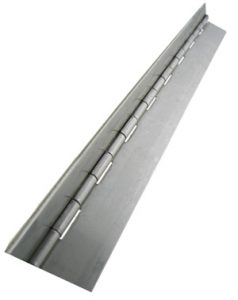
When researching the different types of hinges, you’ll probably come across piano hinges. They work like other hinges by connecting two objects while simultaneously allowing a limited range of rotation. Piano hinges, however, are distinguished from their counterparts by their length. They are longer than most other hinges, making them ideal for applications involving equally long objects or workpieces.
What Is a Piano Hinge?
Also known as a continuous hinge, a piano hinge is a mechanical bearing that runs the entire length of the objects with which it’s used. They feature the same basic design as most other hinges. As shown in the adjacent photo, piano hinges consist of two rectangular-shaped pieces of material that are joined together at the center. The center is known as the knuckle. When the two pieces of material are placed together, a pin is inserted through the knuckle to hold them together.
Piano hinges are characterized by their length. They are designed specifically to run the entire length of the objects with which they are used. If the objects are 12 inches long, for instance, a 12-inch piano hinge may be used to join them. With that said, piano hinges can be designed in any length. Some of them are several feet long. The most common piano hinge length is 72 inches, shorter length piano hinges are cut to length from 72 inches. A hinge is simply considered a piano hinge if its length is equal to or close to that of the objects with which it’s used.
What Are Piano Hinges Used For?
Piano hinges are often used in pianos. That’s why they are called “piano hinges.” Piano lids are typically installed with a piano hinge. The piano hinge connects the lid to the underlying housing unit that contains the piano’s keys and other components.
While they commonly used in pianos, piano hinges are found in countless other products and applications. Doors, for example, are often connected to frames by a piano hinge. Industrial machines and equipment may also feature one or more piano hinges. These are just a few applications for which piano hinges are used.
Benefits of Piano Hinges
Using a piano hinge offers several benefits. For starters, they allow for a more equal distribution of the load. The weight of the joined objects will create a load that acts against the hinge. If the hinge is shorter than the objects, this load won’t be evenly distributed. A piano hinge solves this problem. It will evenly distribute the load across its plates.
Piano hinges are also easy to maintain. You can always use multiple, smaller hinges instead of a single piano hinge. With multiple hinges, though, you may find yourself tightening and lubricating them frequently.
